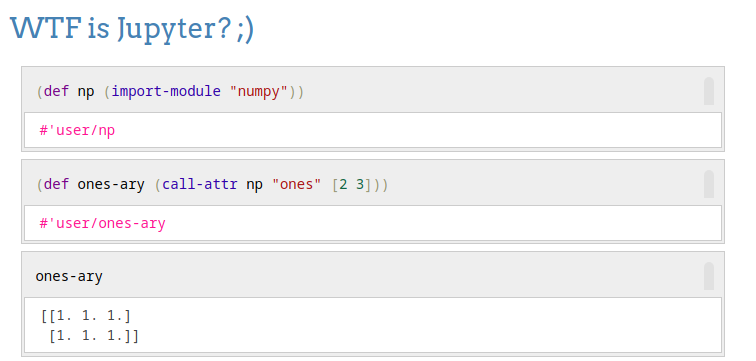
Via Docker Image
prebuild docker images
We provide uberjar Docker images which can be run as follows:
docker run --rm -p 9000:9000 pinkgorillawb/gorilla-notebook:jdk
If you want some samples to play with, you may want to clone and mount the samples repo into the container:
git clone https://github.com/pink-gorilla/sample-notebooks
docker run --rm -p 9000:9000 -v `pwd`/sample-notebooks/samples:/work/sample-notebooks:rw pinkgorillawb/gorilla-notebook:jdk
docker run -p 9000:9000 -v `pwd`/.m2:/root/.m2:rw -v `pwd`/notebooks:/tmp/notebooks:rw --rm clojure:tools-deps clojure -Sdeps '{:deps {org.pinkgorilla/gorilla-notebook {:mvn/version "0.4.9"}}}' -m pinkgorilla.core
via ctr.run
If you aim at running a Docker image built on demand from git by ctr.run (which is awesome) you can
docker run -p 9000:9000 -v `pwd`/.m2:/root/.m2:rw ctr.run/github.com/pink-gorilla/gorilla-notebook:a-branch-name gorilla-notebook.sh -c /root/.m2/custom.edn
custom build docker image
docker build --rm -t me/gorilla-notebook:builder .
inside a servlet container
The uberjar may also work by just dropping it into another webapp (in WEB-INF/lib) . Whether you are lucky
or not depends on the dependencies of your app. If all goes well, Pink Gorilla will appear at
.../your-app-context/gorilla-repl/worksheet.html.
./script/build-uberwar.sh
should give you the standalone war file. Drop it into your servlet container and visit the root url of the webapp.
from source
npm install
./script/build-uberjar.sh
The uberjar is what the Docker image uses. It can be run by executing
java -jar target/gorilla-notebook-standalone.jar
Development
npm install
lein build-tailwind-dev
./script/run-repls-with-jpda.sh
builds css and spins up the webserver and a Shadow CLJS build with JPDA debugging. NREPL should be serving you Clojure and ClojureScript at port 8703.
There are a bunch of aliases in project.clj you might want to check. Try
lein help
VS Code repl
- Run Botebook via /Development
- Jack In
- Server running in your project
- shadow-cljs
- Localhost:8703
- :app-with-cljs-kernel-dev
- you will get a clj repl AND a ljs repl
- the cljs repl will be available after opening a browser window
FAQ
Is Gorilla Notebook ready for day to day use?
The future is uncertain, but we are not aware of any technical issues which should be holding back users.
What about migration from Gorilla REPL?
Being a decendant from Gorilla REPL we aim at a smooth migration path for the brave and also remain backwards compatible. However:
-
We prefer dynamic dependencies (
add-dependenciesin notebooks) and rendering fully delegated to the browser. Getting the parts (incanter,loom,expresso) working dynamically should not be hard. - Given the nature of Reagent, this did not appear to make sense with regards to persisted html. We ended up introducing version 2 persistence (transit based) while still supporting version 1 (shamelessly discarding output).
- URLs have slightly changed. The viewer is at
.../worksheet.html#/viewnow. You may want to try here in case you have it running at port9000. - We introduced compatibility namespaces
gorilla-plot.*,gorilla-renderable.*andgorilla-repl.*.gorilla-plot.*
Extensibility
We try to keep the code shipping with the bare notebook application minimal and aim at runtime customization where possible. The application (Jar/Uberjar/Docker Image) ships two flavors:
:advancedoptimization without ClojureScript kernel support:noneoptimization with ClojureScript kernel support and runtime extensibility
We support JVM library (pomegranate)-, ClojureScript- and JavaScript (requirejs) extensibility at runtime.
Contributing
Contribution of pretty much any kind is welcome. Feel free to get in touch. We are on Clojurians Slack and on Clojurians Zulip #PinkGorillaDev.
History
In 2016, Andreas was working on the first iteration of Gorilla REPL modernisation. Amongst other things, Reagent was introduced at that time. Unfortunately, it went silent - for almost three years. This issue revived the project.

